Energy analysis and carbon credit earned by solar cooker
Mohd. Arif1 * , M. Emran Khan1 and A. Chandra2
DOI: http://dx.doi.org/10.12944/CWE.5.1.24
This chapter presents the study that been carried out to evaluate sensible heating of different load for box type solar cooker. The carbon dioxide mitigation, conventional fuel saved and carbon credit earned as per Kyoto protocol also have been estimated. The pay back period are also estimated for different conventional fuels. If this type of project is installed only in 20% of the Indian rural areas then the carbon credit earned by the system is USD 415 million (Indian Rs. 199 crores) annually.
Copy the following to cite this article:
Arif M, Khan M. E, Chandra A. Energy analysis and carbon credit earned by solar cooker. Curr World Environ 2010;5(1):147-154 DOI:http://dx.doi.org/10.12944/CWE.5.1.24
Copy the following to cite this URL:
Arif M, Khan M. E, Chandra A. Energy analysis and carbon credit earned by solar cooker. Curr World Environ 2010;5(1):147-154. Available from: http://www.cwejournal.org/?p=1132
Download article (pdf)
Citation Manager
Publish History
Select type of program for download
| Endnote EndNote format (Mac & Win) | |
| Reference Manager Ris format (Win only) | |
| Procite Ris format (Win only) | |
| Medlars Format | |
| RefWorks Format RefWorks format (Mac & Win) | |
| BibTex Format BibTex format (Mac & Win) |
Article Publishing History
| Received: | 2010-04-27 |
|---|---|
| Accepted: | 2010-05-21 |
Introduction
Cooking is major necessity for people all over the world. The problem arises when fuel is either scarce or highly expensive. The problems are encountered more pronounced in the developing countries, and particularly in villages and rural areas. Cooking accounts for a major share of energy consumption in developing countries. Most of the cooking energy requirement is met by non-commercial fuels such as firewood, agricultural residues or animal dung in rural areas. The cutting of firewood causes deforestation that leads to desertification. There is a critical need for development of alternative, appropriate, affordable methods of cooking for use in developing countries. There are very favourable climatic conditions in India for all solar energy applications. Solar cookers seem to be a good substitute for cooking with firewood for widespread use in country. The use of solar cookers would not only help in conservation of conventional fuels but also result in the reduction of the release of carbon dioxide (CO2) into the environment.
Several types of solar cookers have been designed in the past four decades. According to the Ministry of Non-Conventional. Energy Sources (MNES),1 around 340,000 family-sizes, box-type solar cookers were sold by January1995. However, in view of the fact that a majority of the population in rural and semi-urban areas of India has access to non-commercial fuels at rather low prices, it is important that the investment in a solar cooker is financially viable to them. Many technically and economically feasible solar cookers are in operation, no broadly valid basis for comparing the achieved performance of one solar cooker with that of another operating under different conditions has found general acceptance.
Fig. 1 shows the breakup of demand of solar cookers in three continents. Table 1 shows the scenario of solar cookers demand in Asian countries.2
In this chapter, the study has been based on weather conditions of India for evaluating cooking time at various load and compared with Kandpal model. Finally, carbon credit earned by box type solar cooker has been estimated as per norms of Kyoto Protocol.
Description of Box-Type Solar Cooker
A box-type solar cooker (Fig. 2) consists of a rectangular enclosure which is usually fabricated of fiber-reinforced plastic (FRP)/ galvanized iron (GI)/aluminum sheet. A trapezoidal, blackened aluminum tray is housed in the enclosure which absorbs solar radiation. Generally, glass-wool padding of 5 cm thickness is used to insulate the tray from heat loss. The tray is covered with a 3-4 mm thick, double-glass lid having a gap of 1 cm between the glasses. The lower glass is usually toughened to avoid cracking during cooking. A silvered or aluminized glass reflector is attached to the inner side of the cover to enhance input radiation. Blackened aluminum or stainless steel pots are used for cooking.3
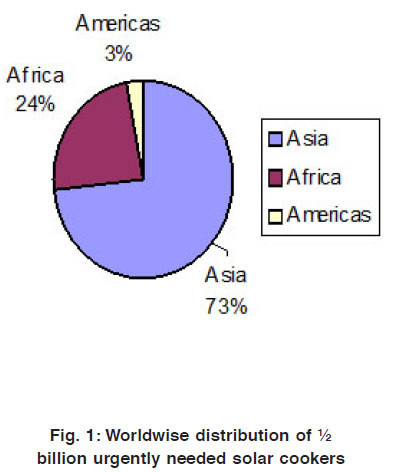 |
Figure 1: Worldwise distribution of ½ billion urgently needed solar cookers Click here to view figure |
As per requirement, solar cookers of different sizes may be used. The family-size (aperture area, Ap = 0.25 m2) solar cooker, standardized by the MNES, is reported to be suitable for cooking meals for 4-5 persons.4
Analysis of Total Incident Radiation on Solar Cooker
There are two types of radiation incident on the double glass cover of the container of the solar cooker. One is the direct incident and other one is the reflected from the reflector. The total incident radiation (IT ) is obtained from the following relation5
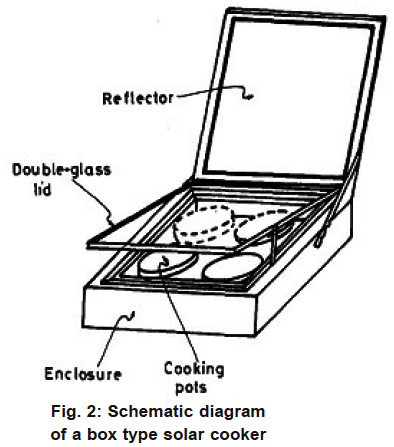 |
Figure 2: Schematic diagram of a box type solar cooker Click here to view figure |
Solar radiation incident on horizontal glass cover = IH ...(1)
Solar radiation incident on vertical reflector = Iv
= IBH Rb + IDH Rd + ρ Rr IH ...(2)
where  ...(3)
...(3)
IBH = Beam radiation on horizontal surface
IDH = Diffuse radiation on horizontal surface
ρ = ground reflectivity which is equal to 0.2
Rb factor for eqn. (2) is calculated as
where θi and θz are the angles of incidence on inclined and horizontal surfaces respectively.
cos θz and cos θi for eqn.(3) may be evaluated from the following relations
cosθz = cosΦ cosδ cosω + sinδ sinΦ ... (4)
and
cosθi = - sinδ +cosΦ + cosδ cosω sinΦ ...(5)
where Φ is lattitude angle (28 o 35’N for New Delhi) and hour angle, ω is calculated from local solar time, ST as
ω = (ST-12) 15° ...(6)
and declination angle,is found from the following expression
Rdr = 23.45 sin [ 360/365 (284+n) ] ...(7)
where n is number of days in a year
RR = 11 cos/22...(8)
where is inclination of the surface
Solar radiation reflected by reflector and received by horizontal glass cover = ρg Iv
where ρg is reflectivity of glass and is equal to 0.8 Hence total radiation received by glass cover
= IT = IH + 0.8x Iv ...(10)
Table 2 shows mean hourly total incident radiation falling on cooker with air mean temperature.
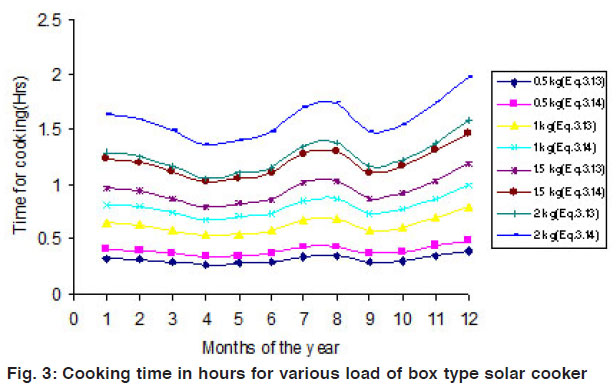 |
Figure 3: Cooking time in hours for various load of box type solar cooker Click here to view figure |
Estimation of Solar Cooking Time
In present analysis, time for cooking between 10 AM to 2PM from box type solar cooker has been evaluated for various loads viz. 0.5 kg to 2kg from the following relation.5
 ...(12)
...(12)
The equation is modified as
 ...(13)
...(13)
after substituting value Tw = Tb and Two = Ta and compared to Kandpal model6,7
 ...(14)
...(14)
Where F1 and F2 6,7 are the two figures of merit of a solar cooker which characterize its thermal performance, H is the hourly insolation on A and Σ m1c1. The total heat capacity of the load (raw food plus water) as shown in Fig. 3.
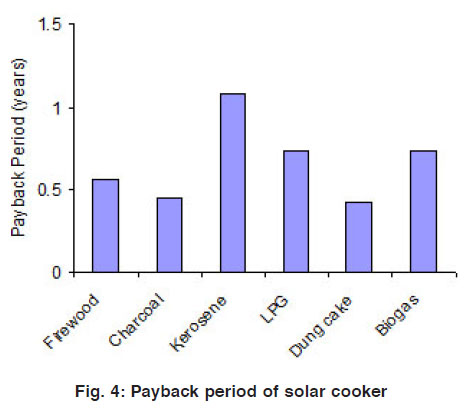 |
Figure 4: Payback period of solar cooker Click here to view figure |
Energy Conservation
In comparison with open fire, saved primary energy by using solar cooker can be written8 as:
E [ Tb Ta C p m] per day ...(15)
This gives E= [(100-20) K 4.18kJ/kg/ K 3kg] =1003.2 kJ per day
Therefore primary energy saved per
person=E/ =3.4MJ per day ...(15a)
where η0 is the overall efficiency
If sun is available for 300 days in a year. Then annual saved primary energy for a family of 5 persons is:
SPEannually = (E/ 0 ) 300×5 = 3.4 MJ×300×5
= 5100 MJ per family ...(15b)
If the meal cooked by the solar cooker for a single household, then amount of fuel saved per year is calculated from the following relation
where
mf = mass of fuel saved per year, kg H.V. = Heating value of the fuel, KJ/kg
= Burning efficiency of the fuel device in % age
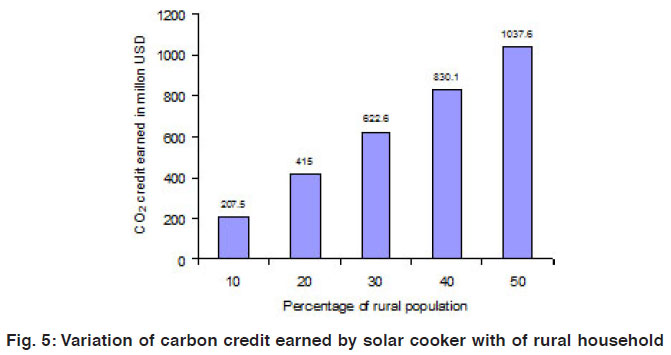 |
Figure 5: Variation of carbon credit earned by solar cooker with of rural household Click here to view figure |
CO2 Mitigation
By considering different fuels (firewood/ dung cake/charcoal/kerosene etc.), the CO2 emissions for each fuel is calculated. In order to estimate CO2 emissions from different fuel for a single household energy (SPEannually), the following expression is adopted [9] as:
0 log[(M ) /( a b )] log[( E M ) /( a b ) 10,11C]
___________________________________
log[(1a ) /(1 b)] ...(17)
where c = Fraction of carbon contents multiplied by 44/12. From the eqn. (17), CO2 emissions are calculated for different fuels. The
Table 3 shows fuel saved in Indian Rupee and CO2 emissions in kg for a single household.
Payback Periods for Solar Cooker
The payback periods have been computed by considering the equivalent savings in alternate fuels, viz. firewood, coal, kerosene, liquid petroleum gas (LPG) and electricity. The payback periods have been calculated by considering the compound annual interest rate, maintenance cost and inflation in fuel prices and maintenance cost per year.
The payback periods, N have been computed by the following relation 12, 13
The payback periods have been calculated by considering the following annual cost: interest rate, a = 10%; maintenance M = 5% of cost of plant; inflation rate, b = 5%.
Where C is the cost of solar cooker (Rs. 3000) and E is the energy saved by solar cooker per year (Rs.).
By considering the equivalent savings in alternate fuels, viz. firewood, charcoal, kerosene, liquid petroleum gas (LPG), dung cake and biogas, estimated payback periods are shown in Fig 4 for different alternate fuels, viz firewood, charcoal, kerosene, liquid petroleum gas (LPG), dung cake and biogas.
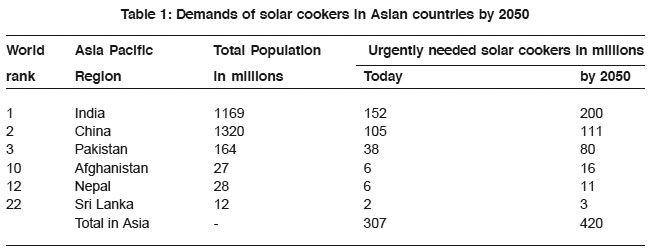 |
Table 1: Demands of solar cookers in Asian countries by 2050 Click here to view table |
Carbon Credit
Carbon Credit Trading (Emission Trading) is an administrative approach used to control pollution by providing economic incentives for achieving reductions in the emissions of pollutants. Carbon credits are a tradable permit scheme. A credit gives the owner the right to emit one ton of carbon dioxide. International treaties such as the Kyoto Protocol set quotas on the amount of greenhouse gases countries can produce. Countries, in turn, set quotas on the emissions of businesses. Businesses that are over their quotas must buy carbon credits for their excess emissions, while businesses that are below their quotas can sell their remaining credits. By allowing credits to be bought and sold, a business for which reducing its emissions would be expensive or prohibitive can pay another business to make the reduction for it. This minimizes the quota’s impact on the business, while still reaching the quota. Credits can be exchanged between businesses or bought and sold in international markets at the prevailing market price. There are currently two exchanges for carbon credits: (i) the Chicago Climate Exchange and (ii) the European Climate Exchange. In the year 2005, 375 million tons of carbon dioxide equivalents (tCO2e) were transacted at a value of € 3.31 billion with an average price of 10.56 per ton. In the first three months of 2006, the average reported price of carbon dioxide equivalent was 16.72 per ton. European and Japanese Companies were the major buyers and China was the major seller of the carbon credits in 2005-06. Demand of carbon credits continued to soar in 2006-07, resulting in an increase in the treaded rate of carbon credits. The present market rate is fluctuating at 20-22 in the European Climate Exchange (www.europeanclimateexchange.com).14
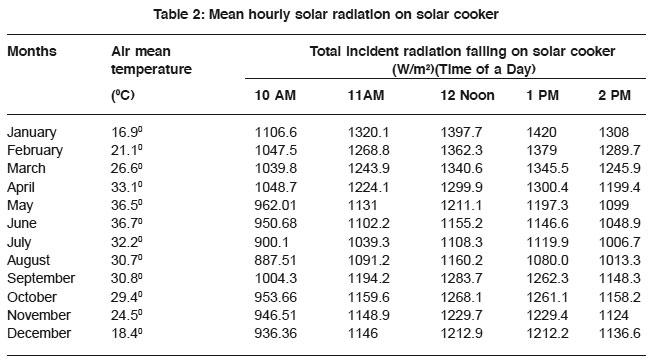 |
Table 2: Mean hourly solar radiation on solar cooker Click here to view table |
Population in Rural Areas
There are 602 districts and 127800 villages in India based on 2005 statistics and as per 2001 census. Each village has more than 1000 population. Most population of India lives in rural areas. Therefore total population of rural areas was 127.8 million in the year 2001.
Present population is given by the equation15
where is population in the nth year, P0
population in the 0th year (the year 2001; P2001 =127.8 million) and i is the annual growth rate in the population, which equals to 2%.
The rural population in the current year will be as
P2009 P2001 (1 0.02) 8 P2001 1.1717
= 127.8 million 1.1717
= 149.743 million
Then total number of families in rural areas
= 149.743 millionCarbon Credit Earned by Solar Cooker
Using eqn. (15b) and eqn. (20), the annually primary energy saved in rural areas is 29.95 million 5100 MJ =152745×103 GJ or 42430×106 kWh.
The average CO2 equivalent intensity for electric generation from coal is approximately 0.982 kg of CO2 per kWh at source16,17. However, 40% is transmission and distribution losses and 20% loss is due to the inefficient electric equipment used. Then the total figure comes to be 2.04 kg of CO2 / kWh.
So, the CO2 emission reduction = 2.04×42430106 kg = 86557.2103 ton. Then CO2 emission reduction by solar cookers14 comes to USD (86557.2×103×21×1.14165) = USD 2075.2 million per annum. Variation of carbon credit earned with household in rural areas is mentioned in figure 5.
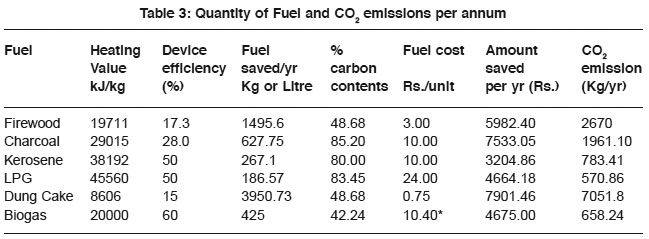 |
Table 3: Quantity of Fuel and CO2 emissions per annum Click here to view table |
Results and Discussion
Eqn. (1) and (2) have been computed using MATLAB software for evaluating the hourly total incidence radiation falling on solar cooker by considering Indian climate conditions. The results are tabulated in Table 2. The eqn. (13) and (14) have been used for calculating monthly cooking time from solar cooker. The comparisons are shown in Fig. 3. Figure shows that lowest cooking time is in the months of April and May and maximum in July and August due to the availability of solar radiation. From the Table 3, it is observed that CO2 emitted by LPG is minimum followed by biogas, kerosene, charcoal and firewood. There is a need to promote renewable energy in rural areas because of non-availability and costlier LPG. The saving of CO2-emission is credited to those who use the solar cookers. Moreover interior cooking enhances the risk of lung and eye diseases that affect millions of people world wide. Free energy will give extra profit for food sellers who use solar cookers for cooking. Assembling, spreading and using of solar cookers create jobs. Indeed, we need to encourage future projects and to multiply clean development mechanism solar cooker projects.
The figure 4 shows that the payback periods based on economic analysis are in increasing order with respect to fuel: charcoal, firewood, LPG and kerosene etc whereas the value of payback period for kerosene fuel is highest, i.e., 1.08.
Conclusion
This paper gives the detailed analysis of box type solar cooker .The cooking time for various loads has been evaluated. The results are compared with Kandpal model as shown in Figure 3. Conventional fuel cost saved for domesting cooking and CO2 reduction per annum are tabulated in Table 3 If this type of project is installed only in 20% of the Indian rural areas then the carbon credit earned by the system is USD 415 million (Indian Rs. 199 crores) annually.
The total carbon credit earned by the system is USD 2075.2 million (Rs. 995 crores) installed in rural areas annually.
References
- MNES. Annual Report 1994-95.Ministry of Non-Conventional Energy Sources (MNES).Govt. of India, CGO Complex, Lodhi Road, New Delhi, India , 1995.
- Bev Blum. Global network for solar food devices: Future priorities. Solar food processing conference, 2009.
- Kumar S., Rubab S., Kandpal T. C., Mullick S.C. Financial Feasibility Analysis of Box Type Solar Cookers in India. Energy; 1996; 21(12): 1257-1264.
- DNES, Annual Report: 1983-84. Ministry of Energy, Department of Non- Conventional Sources of Energy (DNES), Govt. of India, GCO Complex, Lodhi Road, New Delhi, India, 1984.
- Tiwari G.N. Solar Energy: Fundamentals, Design, Modelling and Applications.Book.Narosa Publishing House (2008).
- Mullick S C, Kandpal T C, Subodh Kumar. Testing of Box-Type Solar Cooker: Second Figure of Merit F2 and its Variation with Load and Number Pots. Solar Energy, (1996) 57(5): 409-413.
- Ishan Purohit and Pallav Purohit. Instrumentation error analysis of a box-type solar cooker. Energy conversion and Management (2008).
- www.scienceforpeace.ca/files/solarcooking_forests0609.pdf
- Usmani J.A. Thermal Analysis, Performance Evaluation of Biogas System and Reduction of CO2 emission, Ph.D. Thesis IITD, (1997) 112-116.
- Mohammad Arif and Avinash Chandra, “Energy, Environment and Economic Analysis of Biogas System”, International Research Journal of Material Sciences, (2008) 5(2): 251-256.
- Nahar N.M., Sharma P. and Chowdhary G.R. Design, Development of Low Cost Solar Cookers For Animal Feed, Proceeding of 1st International Conference on Advances in Energy Research, (2007) 182-186.
- Duffie J.A, Beckman W.A. Solar engineering of thermal processes. John Wiley & Sons; third edition. New York (1991).
- Bo¨er K.W. Payback of solar systems. Solar Energy,(1978) 20: 225-232.
- European Climate Exchange. www.europeanclimateexchange.com (accessed July 03, 2008).
- Tiwari G.N. Solar Energy. CRC Press, New York (2002).
- Watt M, Johnson A, Ellis M, Outhred H. Life-cycle air emission from PV power systems. Progress in Photovoltaics Research Applications, (1998) 6: 127.
- Nawaz I, Tiwari G N. Embodied energy analysis of photovoltaic (PV) system based on macro and micro level. Energy Policy, (2006) 34: 3144.






